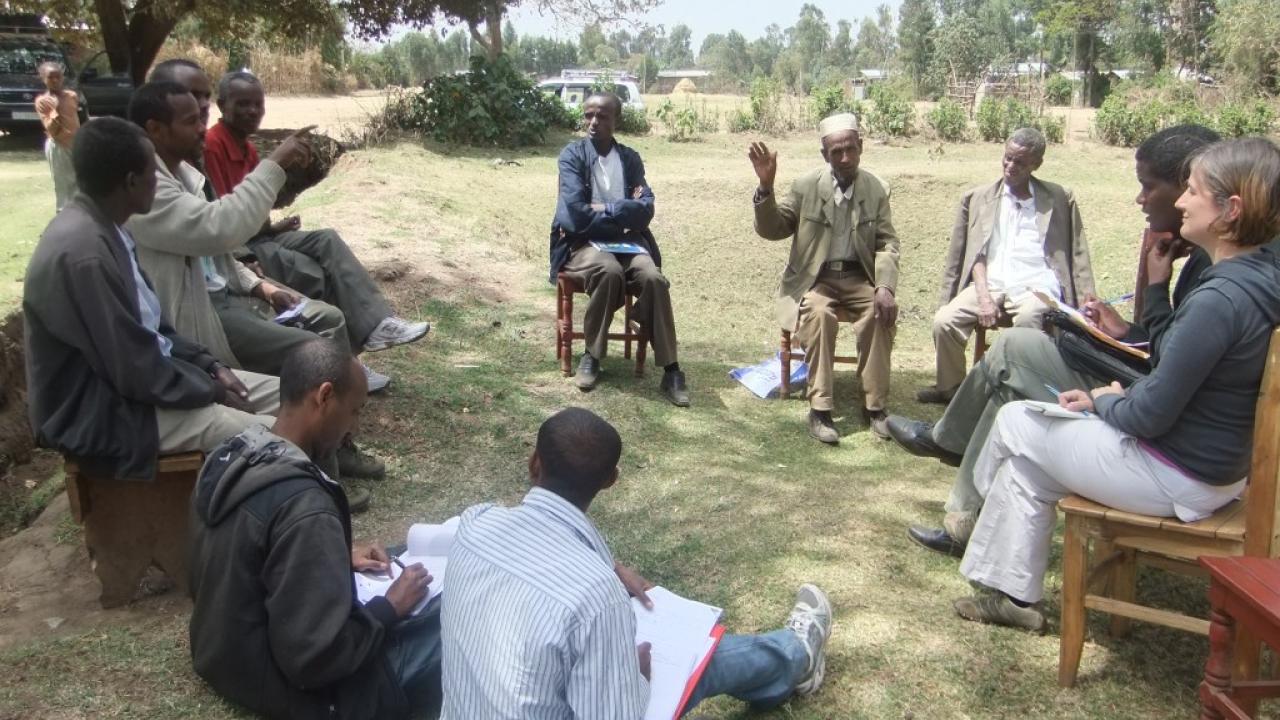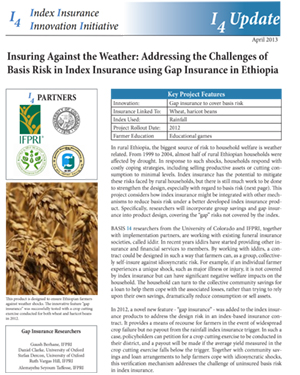
In rural Ethiopia, the biggest source of risk to household welfare is weather related. From 1999 to 2004, almost half of rural Ethiopian households were affected by drought. In response to such shocks, households respond with costly coping strategies, including selling productive assets or cutting consumption to minimal levels. Index insurance has the potential to mitigate these risks faced by rural households, but there is still much work to be done to strengthen the design, especially with regard to basis risk (next page). This project considers how index insurance might be integrated with other mechanisms to reduce basis risk under a better developed index insurance product. Specifically, researchers will incorporate group savings and gap insurance into product design, covering the “gap” risks not covered by the index.
Key Project Features
Innovation: Gap insurance to cover basis risk
Insurance Linked to: Wheat, haricot beans
Index Used: Rainfall
Project Rollout Date: 2012
Farmer Education: Educational games
 BASIS I4 researchers from the University of Colorado and IFPRI, together with implementation partners, are working with existing funeral insurance societies, called iddir. In recent years iddirs have started providing other insurance and financial services to members. By working with iddirs, a contract could be designed in such a way that farmers can, as a group, collectively self-insure against idiosyncratic risk. For example, if an individual farmer experiences a unique shock, such as major illness or injury, it is not covered by index insurance but can have significant negative welfare impacts on the household. The household can turn to the collective community savings for a loan to help them cope with the associated losses, rather than trying to rely upon their own savings, dramatically reduce consumption or sell assets.
BASIS I4 researchers from the University of Colorado and IFPRI, together with implementation partners, are working with existing funeral insurance societies, called iddir. In recent years iddirs have started providing other insurance and financial services to members. By working with iddirs, a contract could be designed in such a way that farmers can, as a group, collectively self-insure against idiosyncratic risk. For example, if an individual farmer experiences a unique shock, such as major illness or injury, it is not covered by index insurance but can have significant negative welfare impacts on the household. The household can turn to the collective community savings for a loan to help them cope with the associated losses, rather than trying to rely upon their own savings, dramatically reduce consumption or sell assets.
In 2012, a novel new feature - “gap insurance” - was added to the index insurance products to address the design risk in an index-based insurance contract. It provides a means of recourse for farmers in the event of widespread crop failure but no payout from the rainfall index insurance trigger. In such a case, policyholders can petition for a crop cutting exercise to be conducted in their district, and a payout will be made if the average yield measured in the crop cutting exercise falls below the trigger. Together with community savings and loan arrangements to help farmers cope with idiosyncratic shocks, this verification mechanism addresses the challenge of uninsured basis risk in index insurance.
Basis Risk
Under any index-based insurance contract, farmers face two sources of uninsured basis risk. The first is idiosyncratic risk, or the risk that a loss unique to an individual farmer may occur that is not observed by the instrument (Area A). Savings and loan groups help individual farmers cope with unexpected idiosyncratic losses. The second source of risk is imperfections of the index as a predictor of yield losses (Area B). A rainfall index predicts average losses for payout determinations; farmers may experience losses greater than predicted, and losses may occur even if the index does not trigger payouts. Gap insurance ensures that payouts are made if yields fall below the threshold, even if the index fails to trigger. Finding mechanisms to reduce basis risk is essential for a successful, scalable insurance product.
Key Lessons
In 2012, the microfinance institution, Buusaa Gonofaa, and Oromia Insurance Company implemented the second year of sales. 2012 sales increased dramatically over 2011 sales, from 634 to 1537 contracts sold. At the site where payments had been made in 2011, take-up was particularly high, with 0.48 policies sold per targeted individual. In 2012, payouts were made for the early season policies in two of three sites, but not for the late season policies. Policyholders at one site requested a crop-cut verification for the late season policies for wheat and haricot beans, per the new gap insurance policy. The crop cuts were successfully completed in a timely manner, and in both cases indicated that local yields were not low enough to justify a payment under terms of the insurance contract.
The research team, in collaboration with implementation partners, now faces the challenge of successful scaling of the project once the research program has ended. This includes designing a marketing strategy, building capacity, and engaging reinsurance firms.
Moving forward, researchers will continue to analyze impacts of the index insurance product, communicate results to key stakeholders, and conduct discussions to facilitate appropriate and successful scaling up. The research team will continue to transfer implementation activities to Buusaa Gonofaa (BG).
